1. Retail's great bounceback

1. Retail's great bounceback
Retailers are feeling cautiously optimistic about the remaining few weeks of 2021 and beyond.
Nearly half of the leaders surveyed – 48% – expect sales at their business to be significantly higher in 2021 compared to 2020. A further 25% expect them to be slightly higher than in 2020. Just 17% expect sales to be lower and 4% are unsure.
This is down to a combination of two things. First, retailers with stores will hopefully be able to keep them open for the lucrative golden quarter. Second, online-led retailers who experienced an influx of customers in 2020 expect to maintain that momentum as customers now familiar with online shopping continue to shop through the channel. Multichannel retailers expect to benefit from both of these factors.
One drinks retail chief executive says: “As an alcohol retailer, we saw an influx of customers due to the closure of the hospitality sector last year. We have gained over 200,000 new customers in this time, many of whom have continued to shop with us into this year.”
For others, such as the chief executive of one fashion retailer, the ability to return to a pre-Covid strategy is giving cause for optimism. “Prior to Covid, we had our best-ever financial year, so our strategy was working, we’ve got a good plan for the business. Next year, our plan is really to just get back onto that track and onto that plan again.”

For others, a staycation summer and consumers who have been waiting to splash the cash are helping. Seasalt chief executive Paul Hayes says: “Generally, there's more of a feel-good factor coming from consumers, with some pent-up demand in terms of unspent cash. I think we'll see a slightly changing dynamic next year as customers spend on hospitality and travel.”
However, while most retail leaders expect a better year than in 2020, there are still several factors slowing the recovery.
While some retailers faced a challenging year because of store closures and disappearing demand, a significant minority faced challenges for other reasons – keeping up with a stratospheric increase in sales. Many of these brands expect the momentum they gained to continue into 2022.
The CEO view: Factors slowing the recovery

Bridget Lea, managing director of commercial, consumer division, BT
“Footfall within our sector is about 40% down and has been since we came out of the third lockdown. Although conversion rates are higher than we’ve ever seen, I find it very difficult to believe that we will reach the sales numbers on the high street and footfall numbers that we had pre-Covid.”
Rachel Osbourne, chief executive, Ted Baker
“Last year, when we were not in a strong financial position, we spent the first half of the year trading for cash online, so we were highly promotional. This year we're taking the decision to be less promotional – that could be a better margin, but it will suppress sales this year.”


At the time of our interviews in June 2021, one leader of a general merchandise chain said his trade in central London the previous week had been 50% down compared to 2019. “There are two key reasons: no tourists and we’re missing a good chunk of office workers,” he said.
Fashion retail chief executive: “Consumers are still nervous about shopping. The challenge we face is, as each week goes by, we have a new set of information. Retailers will be facing that short- to medium-term uncertainty with customer sentiment.”


Greetings card chain chief executive: “I think general cost rises right across the supply chain are going to come to bear, and I think inflation in domestic essentials will lead to restrictions in discretionary spend.”
The CEO view: Rocketing demand and a record year

Timo Boldt, chief executive and co-founder, Gousto: “Last year was a record year. Pre-pandemic, Gousto was growing rapidly. Ultimately, we're benefiting from these mega shifts in grocery – so convenience, sustainability and online. And then last year we grew around 120%.”
Chris Griffin, co-owner, Secret Sales: “We’re forecasting industry-leading growth, somewhere between 500-600% growth in revenue. We’re expanding internationally so we’ll be launching new country-specific websites, and we’re seeing huge consumer demand to shop online.”


Electricals retailer chief executive: “Last year our online business more than doubled in size and we had healthy double-digit growth despite having our stores closed for eight months of the year… technology [is] playing a more central part in millions of customers’ lives. We’re not expecting the same levels of year-on-year growth, but we are expecting to hang onto the gains that we’ve made because we think our market is now structurally larger.”
Grocery chief executive: "We were expecting, when hospitality opened, that we would see a fall in sales but we have seen the reverse. It’s been very difficult in our industry at the moment to establish what that growth is but I think [for us] it’s largely due to keeping our colleagues and customers and really taking care of our supplier base. We have a large cohort of smaller suppliers and many of whom we have worked with personally to ensure we support their businesses because quite a lot of those businesses have been impacted."


Online sports retailer chief executive: “We're in a super-fortunate position to be in an industry that just went totally crazy over the pandemic. Everybody was just flocking to buy bikes.”
Panni Morshedi, chief operating officer, Beauty Pie: “We saw a huge demand and, in fact, you know, we didn't have enough inventory, and that's lesson learned now. But we saw people really coming online and experiencing the brand, and wanting to become a member and see the benefits.”

Looking ahead to 2022
The optimism continues when looking forward into next year – 43% of the 54 UK chief executives expect sales to be significantly higher, and 45% expect them to be slightly higher. On profitability, 28% expect much better than 2021 and 40% expect slightly better.
This optimism is reflected in wider growth predictions for next year: the CBI is forecasting GDP growth of 6.1% in 2022. As far as retail sales go, the Centre for Retail Research expects a 4.5% uplift next year.
Many retailers share this optimism, such as one fashion leader keen to get back to a successful pre-Covid strategy: “We expect to see profits growing next year by maybe 15%. The pandemic has allowed us to restructure the whole business, and accelerate lots of activity, whether it’s digital or the wholesale business, or rejuvenating our international business. We’re feeling more bullish than we were pre-pandemic.”
Mamas and Papas chief executive Mark Saunders is also feeling confident. “This will be the most profitable year the business has ever had in 40 years. We are starting to reap the benefits of all the plans that we put in place 20 months ago.”
More broadly, there are several factors expected to affect sales and profit in 2022.
Business rates
The government is set to publish a review of business rates by the end of 2021, with retail bodies calling for a range of changes. These include more regular revaluations, which they say will lead to fairer rates, and an overall reduction of the business rates burden, which multichannel retailers have long argued unfairly penalises store-based businesses over their online counterparts. The UK government introduced a 100% business rates holiday in March 2020 when the pandemic hit, which shifted to a discount of two-thirds in June 2021. Retailers say the outcome of the autumn review could have a significant impact on their profitability.
Gift Universe chief executive Paul Kraftmann says: “It's the difficult question – a lot of it [profitability] depends on what happens to the business rates.”
Alia Sirina Hawa, managing director, UK and Ireland at L’Occitane, agrees: “Are [the government] going to review them significantly as they have promised they would do? They no longer reflect the level of sales. If we don't have [that review], our profit could potentially be flat or lower.”
The boss of a leading carpet and flooring retailer shares these concerns. He says: “There will be headwinds next year compared to this year. The rates holiday that we’ve had this year has obviously been a benefit to profitability. And while we’re expecting a government review of rates in the retail sector in the second half of this year, we are expecting that some costs will remain.”
Changing high street and footfall
The high street was changing before the pandemic, but months of lockdowns accelerated this. The closure of chains such as Topshop and Debenhams have left holes which are yet to be filled, while others, such as John Lewis, announced plans to convert some of their retail space into other uses. In the second quarter of 2021, the overall UK vacancy rate increased from 14.1% in the first quarter to 14.5%, according to the Local Data Company (LDC). The vacancy rate has now been increasing for over three years, since the first quarter of 2018.
Consolidation and the changing high street landscape are front of mind for some. The leader of one variety store chain says: “The obvious concern around the UK is just what will replace the big empty units that are now vacant.”
One fashion retail chief says the consolidation will help remaining businesses. “I just believe the high street will offer more to those who are still there and have survived it.”
Lower rents
High vacancy rates have led to landlords being open to discussing lower rents and new terms, such as turnover rents. According to a September 2020 Savills report, 86% of UK landlords expect shopping centre rents to fall. Rents are expected to fall by an average of 22% on the high street, 30% in shopping centres, 13% on retail parks and 34% on leisure schemes.
The boss of one supermarket chain says a rent adjustment will help. “Our landlords are working to re-establish rent and represent market rent, which has been very helpful. Some of our high costs are now much trimmer.”
The return of tourism
Tourism accounts for a significant portion of some retailers’ sales, and the slow return of international tourists in 2021 is hitting the retail industry hard. Forecasts by the VisitBritain agency predict UK-wide domestic tourism will be worth £51.4bn in 2021, down from £91.6bn two years ago. Foreign tourist spending is forecast to be £6.2bn, less than a quarter of 2019’s £28.4bn.
London has been particularly hard hit, with spend declining by £10.9bn in 2020 compared to 2019 and with retail vacancies on Oxford Street hitting their highest level in a decade in 2021, according to LD. In response, businesses such as Pret a Manger have pivoted to a regional rollout, while Harrods managing director Michael Ward has said it will take him “years to rebuild the business”.
Retail leaders we spoke to are cautiously optimistic. One department store chief says: “I’m expecting a small return of international customers. They are a large part of our customer base.” And L’Occitane’s Hawa adds: “We are hoping that there will be a return of international travellers and tourists, but also that there will be the return of the domestic customer with the return to the office.”



Brexit
The pandemic has masked the full impact of Brexit on the economy so far, but the signs aren’t positive. The OECD has warned that the UK could suffer more longer-term economic damage than other industrialised nations because of Brexit’s combined impact with Covid-19. In February 2021, the European Commission predicted Brexit would generate a loss in GDP by the end of 2022 of about 2.25%, compared with continued EU membership.
Many retailers expect a negative impact from Brexit in 2022 – nearly half (48%) expect a slightly negative effect, and 4% a hugely negative one. Just over a quarter (27%) expect to see no difference.
Many retailers are facing an increase in costs as a result of greater red tape and administrative and logistical hurdles to jump over.
For some, the impact is dramatic: “The increased cost is equivalent to wiping out the annual profit of the Irish organisation. It's quite a strong statement, but the Irish business, it's under 30 stores, and it makes about £300k a year – that would be completely wiped out by the increase in taxes from moving stock from the UK to Ireland,” says the variety store chain leader.
These increased costs are likely to reduce the size of a number of businesses. The chief executive of an outdoor retailer says: “We have a significant European business that's going to be considerably smaller going forward, given all the tariffs that are in place.” The chief executive at a biking retailer agrees, saying: “It’s actually significantly negative in terms of our profitability; it’s millions of pounds worth of cost that we wouldn’t otherwise have. It’s not going to blow us off course but it’s giving us unwelcome friction.”
Some are facing two issues – increased costs and recruitment challenges. Paul Kraftmann, chief executive at Gift Universe, says: “There is an issue of paying double duty if we bring [stock] to the UK and then plan to sell it to Europe. At the moment, all I can see are the negatives. There's a shortage of HGV drivers that's affecting our fulfilment just to our local stores, let alone into Europe, so the whole thing is a shitshow.”
Recruitment challenges
The shortage of HGV drivers and warehouse workers is emerging as the most pressing problem to have emerged from Brexit, with the pandemic having complicated the issue: many workers went home to Europe during lockdowns, and Brexit has put them off or prevented them from returning.
The BRC and Logistics UK, which represents freight firms, wrote to business secretary Kwasi Kwarteng in August 2021 warning of the worsening impact on supply chains, and asking for a review of plans not to grant temporary work visas to drivers from the EU. They say a shortfall of about 90,000 HGV drivers “is placing increasingly unsustainable pressure on retailers”. The pandemic halted driver training for 12 months, while an estimated 25,000 EU drivers have returned home.
Overall immigration has nosedived in the last year – the government has reported that in total, just 668,979 visas were granted in the year ended March 2021, 78% down on the previous 12 months. Retailers have responded by raising drivers’ pay in a bid to attract workers – John Lewis and Waitrose by £5,000 a year – while M&S is offering a £2,000 signing-on bonus.
Many of the retail leaders we spoke to are feeling the effects of reduced immigration.
The boss of one high street fashion chain says: “There will be challenges in terms of talent. It used to be something like a quarter of our UK workforce were EU nationals and it’s much less now. Brexit is something I could have done without as CEO of a global business.” The effects are being felt across multiple sectors – the chief executive of a bakery chain says: “It has multiple impacts, so exports are more expensive and difficult and labour supply is impacted by lack of migrant workers.”
While the managing director of a health and beauty chain adds: “We have trouble with supply, we have trouble getting people, there is nothing good about Brexit, from our business perspective.”
Timo Boldt, chief executive and co-founder at meal delivery service Gousto, says government support is needed. “The net immigration number looks really bad and we really need the government to support, you know, highly skilled employees to come in fast. We've got to get rid of bureaucracy, it's taking too long.”
While HGV shortages are the most urgent, the problem is rearing its head in a range of areas. Peter Pritchard, group chief executive at Pets at Home, says: “I’m most concerned about availability of talent and employment, which has got significantly harder. We run a veterinary business which has been very challenging because we have a lot of non-UK nationals and in pockets of the country those areas have been very difficult to recruit in.”




